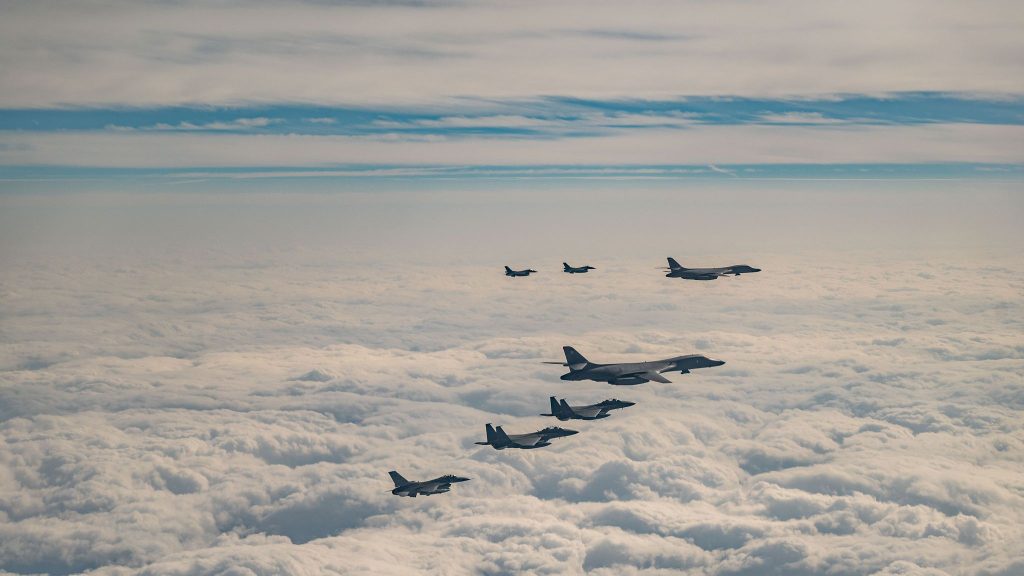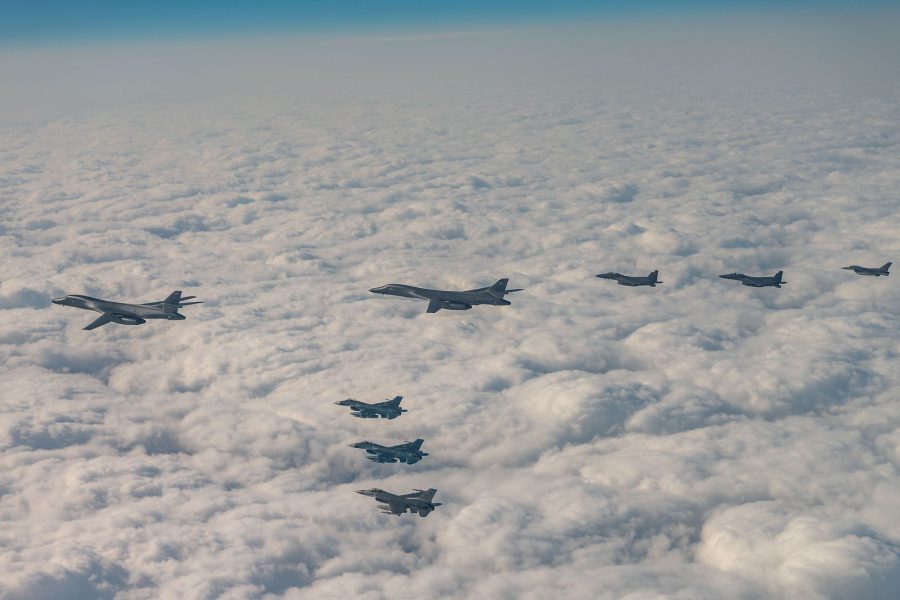Two U.S. Air Force B-1B bombers flew from the mainland U.S. to participate for the second ever trilateral aerial exercise with South Korea and Japan on Dec. 20—the latest in a surge of bomber exercises over the Korean Peninsula in 2023.
The bombers, assigned to the 28th Bomb Wing at Ellsworth Air Force Base, S.D., have now returned to Ellsworth as of Dec. 21, a 7th Air Force spokesperson told Air & Space Forces Magazine.
U.S. F-16 fighters assigned to the 8th Fighter Wing and the 35th Fighter Wing, along with South Korean F-15Ks and Japanese F-2s, escorted the two bombers over the waters near South Korea’s southernmost island, Jeju. KC-135 Stratotankers stationed at a U.S. base in Japan also provided aerial refueling support for the B-1Bs during the trilateral exercise, the spokesperson added.
In late January 2023, U.S. Defense Secretary Lloyd J. Austin III promised during a visit to South Korea, formally known as the Republic of Korea, that the U.S. would step up its military exercises with the ROK, to include expanded use of air assets like bombers.
That pledge was followed by regular appearances of B-1 and B-52 bombers above or near the Korean Peninsula nearly every month. The Dec. 20 exercise marked the Lancer’s sixth appearance in a joint exercise with the ROK this year, while the Stratofortress has participated eight times, including a historic touchdown on the Korean Peninsula in October, a sight not seen for the last three decades:
- On Feb. 1, two B-1s and F-22 Raptors flew with South Korean F-35s over the Yellow Sea.
- On Feb. 19, two B-1s flew with F-16s and ROK F-35s through the Korean Air Defense Identification Zone.
- On March 3, one B-1 flew with South Korean F-15K and KF-16 fighters over the Yellow Sea.
- On March 6, one B-52 flew with South Korean F-15s and F-16s through the Korean ADIZ.
- On March 19, two B-1s flew with F-16s and South Korean F-35s.
- On April 5, one B-52 flew with U.S. F-35Bs and F-16s and South Korean F-35s
- On April 14, B-52s flew with USAF F-16s and ROKAF F-35s.
- On June 30, multiple B-52s flew with USAF F-16s and F-15Es and ROKAF F-35As and KF-16s.
- On July 13, one B-52 flew with USAF F-16s and ROKAF F-15s over the peninsula.
- On Aug. 30, one B-1 flew with USAF F-16s and ROKAF FA-50s.
- On Oct. 17, a B-52 landed in South Korea and participated in a joint drill with South Korean F-35s.
- On Oct. 22, that B-52 flew with three U.S. F-16s, two South Korean F-15Ks, and four Japanese F-2s.
- On Nov. 15, one B-52 was escorted by USAF F-16s, U.S. Marine Corps F-35Bs, and ROKAF KF-15s and KF-35s.
The October exercise between the U.S., South Korea, and Japan, marked the first ever trilateral air training between the three countries—Dec. 20 marked the second such occasion.
The increase in exercises comes as North Korea continues to advance its nuclear capabilities, along with growing threats from Russia and China. Washington’s non-nuclear allies increasingly rely on U.S. bombers for visible shows of deterrence.

This latest exercise was held two days after North Korea launched an intercontinental ballistic missile launch on Dec. 18. Pyongyang’s state media claimed it reached an altitude of 4,050 miles, covering a distance of 622.6 miles, and accurately hit the intended target in the sea.
On Dec. 19, a day after Pyongyang’s missile launch, the Pentagon announced the full activation of a real-time North Korean missile warning data sharing mechanism with South Korea and Japan.
The Department of Defense also confirmed the joint establishment of a comprehensive multiyear trilateral exercise plan the same day, hinting at a potentially increased presence of U.S. bombers in the region in 2024.
